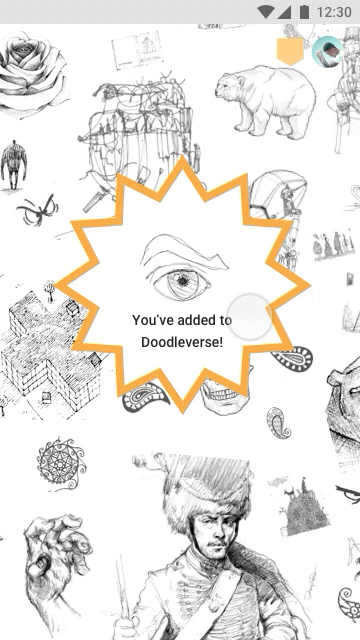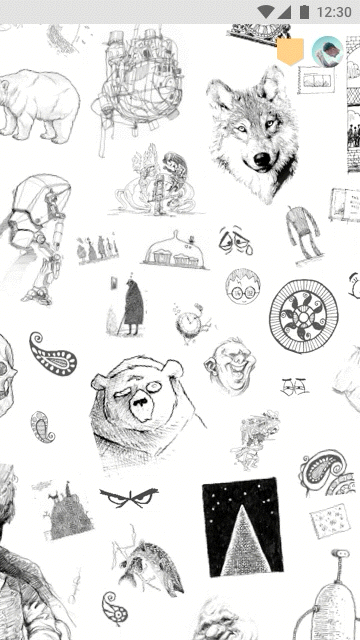
Product Creation
Doodleverse
New Way to Learn Art
SUMMARY
Situation
Adults who are interested in drawing but are not confident hesitate to conduct art activities. They want to learn basic skills but do not know where to start.
Approach
Build a structured environment to learning drawing that provides
-
Guided instruction
-
The opportunity to belong to a community
-
Low cost of time, energy & money
so users are able to easily access and build their creative confidence.
ROLE
-
Conducted Research, synthesized the findings, created a persona, and user journey map, task flows, wireframes with the team
-
Created prototypes, led user testings, and refined the wireframes based on team meeting results
-
Created a hi-fidelity wireframes and prototype
TEAM
Bryna O'Neill
Sean Ward
Talia Saltzman
METHOD
Screen Survey
User Interview
Competitive Analysis
Affinity Mapping
Persona
User Journey Map
Feature Prioritization
Task Flow
Wireframes
Prototyping
Usability Testing
TIMELINE
April 2018
2 weeks

How can we help people who want to create art?
Hypothesis
There are people who want to make art but cannot do due to other constraints or responsibilities. (i.e. too busy with their work schedule)
To help them, we conducted research to
-
Identify people who want to create art but are unable to do so
-
Understand their needs and pain points
-
Understand the art education experiences of people who are doing art and people who are not
Initial Survey
Experience In & Interest About Art & Drawing
34 responses | Age: 20-65
Do you think drawing is learnable?
Yes 97%
No 3%
Do you have an interest in learning how to draw?
Yes 75%
No 12%
Maybe 13%
Can You Draw?
Very basic 1%
Yes 56%
No 12%
Yes but not well 31%
Gap between interest
development of drawing
On the initial survey, the participants responded that
-
Many who are interested in learning drawing are able to draw when they begin
-
But they cannot draw because they have not developed their ability
User Interview
Why do people who want to learn to draw fail to develop their interest?
6 Interviews about Making Art
After our survey, we found a gap; we conducted our first round of interviews to figure out the reason why people with interest in art do not develop their ability

The Main Barrier
Confidence
"I can't start because I am not good at it"
-
Anybody can start drawing and develop their skills with simple materials like pen and paper.
-
But many who answered that they cannot draw are question their talent and ability
Our Product Vision
Help people be confident in pursuing their artistic & creative inclinations.
User Interview
How do people build confidence?
Creative Confidence Cycle
4 Interviews about Confidence
During our second round of interviews, we found a cycle including two factors that help develop people's confidence. When people gain confidence, they become motivated to move to the next step and the individuals continues to build their own confidence.

in Community Space
= Learn Drawing Skills
After finding Creative Confidence Cycle, we looked into the details of the two points to
-
understand the problem better
-
find a direction towards a solution
How users want to
Learn Skills
(Gain Knowledge)

Guided Instruction
with visual prompts & step-by-step lessons

Low Cost
of time, energy & money
Why users want
Community Space

Belonging
Users want to feel like they belonging

Get feedback
Users want to get constructive feedback

Collaboration
Users want to collaborate with other people to achieve goals
Based on the research insights, I created a persona , Damien, to represent the users and to solidify their behavior, needs, and pain points
PERSONA

Damien's Journey Map

Main Pain Points
-
In need of art education
To start art creation, Damien believes he has to learn basic skills and knowledge first
-
lack of access to art education
Damien's work schedule does not fit with any existing art classes

Problem Statement
People feel that their creative learning is most effective in structured environments with guided instruction, buildable elements, inclusive community and feedback.
Adults who have creative interests but lack confidence in their abilities have difficulty accessing these structured environments to pursue their interests.
How might we build a digital tool that provides step by step instruction anywhere and builds their creative confidence?
APPROACH
Platform Choice
Since Damien should be able to access our product anywhere anytime with low cost of time, energy & money

Primary Platform
Mobile
Primary Design Standard
Android
(because Android's global market share is 85.0%)
Features, Wireframes
& Design Iteration
Defining Features

Ideation & Paper Prototype
To solve Damien's problem,
-
my team ran 2 rounds of ideation sessions in attempt to implement Creative Confidence Cycle.
-
We then prioritized features based on importance and feasibility.
-
To test if our solution works, we made a paper prototype and conducted usability testing with 4 users
Creative Confidence Cycle
in Action
Based on our research findings, we created a circulation flow leading Damien to receive inspiration from the community space, to learn and to create, and to share the results with his community.

Refining Features
Task Flow
Based on feedback from the testing, we created an ideal path toward refining the features

Wireframe, Prototype & Iteration
-
Using the flow, we refined wireframes and prototypes in digital form.
-
After conducting another round of usability testing, we revised the wireframe in higher fidelity using feedback

V1

V2

V3
Exploration
Discovery
Lesson



Community space
-
Users post drawings and doodles.
Inspiration & Collaboration
-
Users choose other user's doodles to learn how to draw them.



Lesson summary
-
Users can prepare recommended materials.
Step-by-step lesson
-
Videos show the process in detail.
-
Users can easily replay each step.
Initiate learning
-
Each drawing is linked to related lessons.
Getting Feedback
-
Like function
-
Inspired: The number of people taken lessons from the drawing.
Iteration
V2


V3

"I already chose to draw this eye. Why do I have to choose 'Eyes' again?"
Issue
8 out of 8 users failed to understand that
-
the drawing they chose is not the outcome they are going to learn but a another user's drawing.
-
they should choose a related category of the drawing and then choose a lesson.
Approach
Users already understood they had to choose a lesson at the lesson list page. Therefore, we merged the two pages. The related lessons are listed on each drawing post to
-
explain better that they have to choose a related lesson.
-
minimize the number of steps for taking lessons.
Posting Preparation


Vectorizing
Choosing next steps
Tagging
Each tag is a lesson category

Share
Tracking Progress



Overall progress
-
Because learning art is non-linear, the skill map is radiant.
Motivate engagement
-
To level up, users must give feedback and share their work as well as take lessons.

Other users will give feedback & get inspired
V3
V2
Iteration

"I have no idea what these numbers mean."
Issue
3 out of 4 users did not understand that the written menu at the top of the page that summarizes what the user has to do to to move to the next level.
Approach
Users had no problem understanding the information on the map itself, so
-
we got rid of the written menu to minimize the confusion,
-
and gave an explanation about the map instead.


Pricing & Potential Partner
Pricing Strategy
Freemium
Unlock paid content, including lessons related to
-
specific art materials like watercolor or charcoal
-
specific drawing styles of partners’ content.





Potential Partners
Animation Studios
Commercial entities like Marvel, Disney, or Studio Ghibli;
fans can learn how to draw specific characters or styles.
Measure of Success
-
Recurring use: investment in their learning
-
Recommendation: experience to be shared
-
Completing learning cycle: commitment to the task, clarity of task
-
Engagement/Participation through feedback or art: build a community
REFLECTION & NEXT STEP
The connection between the lesson feature and collaboration on community space was one of the unique characteristics of our product.
-
It was a challenge to make users understand that the tags of each posted drawing was different lesson categories. We have refined the UIs and languages to better explain this feature, but we still have to test and iterate the wireframes to develop the flow.
-
Users are hesitating posting their drawings after the lessons. They want to refine their drawings more before sharing, so we have some concern about reminding users to share their drawings after they refine them.